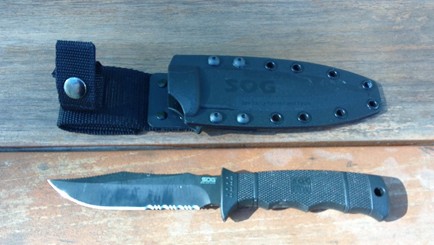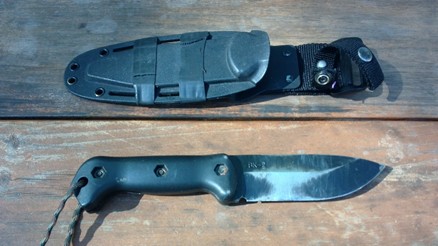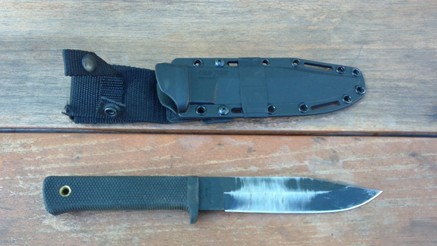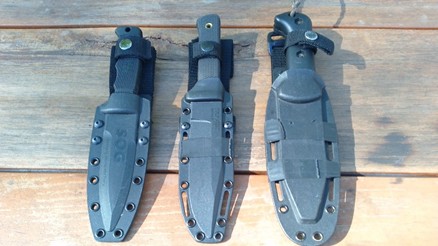Outdoorsmen love knives. The reasons for this are varied, but for me it’s because of the utility they offer. If all you have is a good blade and the right skill set you could potentially survive in the wilderness for a long time.
How so? Let’s think of the Rule of 3′s for a moment and see how a knife could help.
Rule of 3′s
- You can survive 3 minutes without air
- You can survive 3 hours without shelter (in inclement weather)
- You can survive 3 days without water
- You can survive 3 weeks without food
- You can survive 3 months without human interaction
(These are all highly generalized of course, but the rules give you a “survival lens” to look through when planning your survival strategy.)
Could a skilled woodsman survive without a knife? Yes, but the people who could do this are few and far between. Even the folks who could survive indefinitely in the forest with just a knife and their knowledge and skill are probably one in 10,000 or even fewer here in the United States.
How can a knife help? A knife can help you to cut brush and limbs to make a shelter, split wood, cut tinder and kindling, and make a bow drill to get a fire started. It could help you take bark from a birch tree to make a container, so you can boil water for safe drinking and cooking. It can help you to cut sticks for a figure 4 trap to get small game. It could help you harvest different types of raw materials for cordage, which is very helpful in any survival situation.
You get the idea. A good knife is an extremely useful resource any time you’re in the woods, but much more so when your life depends on it.
A good survival knife needs to be reliable, durable, and tough. Here are seven characteristics to look for when buying a good survival knife. This article sums up the characteristics perfectly and I encourage you to check it out before reading further.
It’s not hard finding a knife under $100, but finding a good knife – something you’d trust your life to – is a different matter.
The following knives all have their strengths and weaknesses and it all comes down to personal preference and what you need the knife for. This is by no means an all-encompassing list, it’s simply a few of the knives I’ve had experience with and would recommend.
Let’s get started!

With an overall length of nine inches this clip point, partially serrated knife packs a lot of utility for it’s relatively small size. My first note about this knife is that it’s sharp coming out of the box. And I mean sharp. After I opened it up I immediately took it out in the woods to try out. It was still winter and I was using it to split some kindling for the stove in my military ECW (Extreme Cold Weather) tent. I was twisted around in an awkward position and instead of setting the knife on top of the wood when I went to baton it, it slid down the side and touched my finger very lightly. I was surprised at the amount of blood that poured out of the cut. After wrapping the wound with duct tape I used a lot more caution with the blade.
It handled the batoning with no problem and I didn’t notice any appreciable dulling of the blade.
The SOG Seal Pup is light compared to what I’m used to. I can strap it to my belt and forget it’s there until I need it. It’s great for jobs like cutting meat, cordage, and whittling those little pieces of dry wood to start a fire. It’s good for small jobs like making a bow drill set and would be perfect for cutting food up at camp. You could also use this knife for skinning small or large animals.
About the knife:
This is a full tang knife, or as close as you can get to it.
The Tang of a knife is the portion of the blade that extends down into the handle. The Tang and the blade are one solid piece of steel. A Full Tang, or tang that goes all the way to the base of the handle, is considered the best for a quality survival knife. The full tang gives the entire knife strength. On cheaper knives the blade is only connected to the top of the handle and can break off.
The handle is made from GRN or Glass-Reinforced Nylon. It fits in my hand nicely and has an excellent grip. It feels like rubber and has a raised diamond pattern, so even if it gets wet it doesn’t feel slippery. Again, this is a smaller knife, but I don’t think someone with big hands would have a problem using it comfortably.
SOG prefers AUS-8 Stainless Steel for their blades. I won’t get into the whole “stainless vs. carbon” debate, but I will say that this knife comes sharp out of the box and you need to treat it with care.
Being stainless you don’t have to worry about it rusting as much as you would with a carbon blade. Some people say it’s harder to get an edge on the blade, but I’ve always had good luck with them. I don’t think I could sharpen the blade as well as they did at the factory, but I have a stainless steel dive knife I’ve had for years and it’s still in tip top shape and it has a hell of an edge too. If the Seal Pup stands up to corrosion as well as that dive knife it should be serviceable for many years to come.
The blade is partly serrated and has a powder cover. On the back of the blade is a thumb rest for that fine detail knife work you might find yourself doing. My experience with the powder cover is that it eventually wears off after using it in the field for awhile. The SOG still has most of it left, but you’ll see pictures of my other knives where it’s worn off in the middle of the blade where I baton wood.
One thing about serrated edges is that if you use them for chopping it will eventually wear the serrated part down or even break them. Up until recently I really didn’t like a serrated edge, but I’ve tried a few knives recently that are changing my mind up to a point, this blade being one of them.
The knife I ordered comes with a basic Kydex sheath. Some people don’t seem to care for Kydex, but I like it because it’s formed to the shape of the knife making it hard to fall out if you don’t strap it in.
Overall Score
I give this little powerhouse a score of 4 out of 5 stars. It’s sharp, tough, and sits on your belt without pulling your pants down or otherwise causing discomfort.
In most cases I’d rather have a smaller knife than one that is too big and if I had choice I’d go with this one.
Ka-Bar Becker BK2

One of my personal favorites is the Becker BK2. It lists a higher price in the last link than it does on Amazon, so check it out here if you want to buy.
When you pick this bad boy up you know you’ve got a serious tool in your hand. It’s 1/4″ thick of solid 1095 Cro-Van steel with a drop point and a blade length of 5 1/4″ and a weight of 1 pound. The overall length of the knife is 10 1/2″, which is small enough to fit comfortably in a pack or to be worn on your belt without banging your ankles.
It keeps a pretty good edge, but what I like about this knife is its muscle. I’ve pried stuff with this knife I would never try with another for fear of breaking the blade. I’ve heard it described as a crowbar with an edge, and while it made me laugh, it really is a good analogy.
I’ve used this knife for about four or five years now and it’s still my main go-to knife. I have pounded this knife, thrown it, pried with it, and abused it in more ways than it deserves and it’s taken it all without complaint. One of the things I like about it is that it’s heavy, which makes it good for chopping. Other knives I’ve used, like the Seal Pup, are just too light to make a good chopping tool, but the Becker BK2 doesn’t have that problem.
The Zytel handle can be a little slippery when it’s wet (even then it’s not too bad), but I put a piece of paracord on the end as a wrist wrap and haven’t had any problems with it slipping out of my hand.
The newer handles have a pummel on the base of the handle, but my first generation does not. This is good for pounding stakes, cracking nuts, bones, or whatever might need to be pounded.
As you can see from the pictures I’ve used this knife a lot. Its strength lies in it’s durability and because of its weight it’s excellent for chopping and limbing branches. When I limbed my tipi poles I used this knife and it made short work of it. When you hit a thumb sized branch at the base of the limb it will take it right off without hesitation.
This knife wouldn’t be so great for skinning small animals, but for most other small jobs it does just fine.
I keep this knife pretty sharp, but haven’t been able to get an edge on it like the Seal Pup.
This also comes with a Kydex sheath and if you look at the picture you’ll see I’ve got some Ranger Bands wrapped around it where I store a firesteel. With these two components it makes a very good mini survival kit for when I’m walking around in the woods with just the knife on my hip.
Overall Score
In today’s category I give the Becker BK2 4 3/4 stars out of 5. It’s not perfect, but it’s pretty damned close.
Ka-Bar Stats off the website:
| Weight | 1.0 lb. | Steel | 1095 Cro-Van | ||
| Blade Type | Fixed Blade | Lock Style | N/A | ||
| Measurements | Blade length 5-1/4″; Overall length 10-1/2″ | Grind | Flat | ||
| Edge Angles | 20 Degrees | Handle Material | Zytel | ||
| Shape | Drop Point | HRC | 56-58 | ||
| Stamp | KA-BAR Becker | Butt Cap/Guard | N/A | ||
| Pocket Clip | N | Made in | Knife Made in USA, Sheath Made in Taiwan | ||
| NSN | 1095-01-493-1798 KNIFE-COMBAT | Blade Thickness | 0.250 | ||
Cold Steel SRK (Survival Rescue Knife)

Another excellent knife is the Cold Steel SRK. I bought this knife after talking with Leon Pantenburg at Survival Commonsense. Read his review here. After doing some research I discovered that it’s a universally well liked knife. Leon is a pretty savvy outdoorsman and I liked what he had to say about the knife, so I gave it a try.
I’m glad I did. It’s a tough, good looking knife with a 6″ blade. It weighs 8.2 oz, a good deal less than the BK2 and I’ve found that when I’m going through one of my “pack light” phases the BK2 gets taken out and this knife goes in.
This is an excellent all around knife that sits between the SOG Seal Pup and the BK2 in several different categories. This knife is made from stainless steel as well, but of the three knives I’ve had the best luck sharpening this one. It has a great edge and I’ve managed to keep it very sharp using my sharpening stone. When I hand this to people I have to warn them, “It’s sharp. Be careful.”
The SRK is lighter than the BK2, but heavier than the SOG Seal Pup, and of the three has the longest blade at 6″. Weight and blade-wise it’s not as good at chopping as the BK2, but better than the SOG.
It’s not as thick as the BK2 at 3/16″ of an inch, but I haven’t had any problems with it during field use. Indeed, it performs the tasks I use it for extremely well and it’s a pleasure to hold in my hand. Again, in the picture you can see the black coating wearing off, but I chalk this up to every day use and don’t really expect a knife to hold onto its finish with any serious use.
The overall length of the knife is 10 ¾”, which is within the range of what I prefer for a survival knife. When you hang it off your belt it’s light enough that it’s no bother and small enough that it doesn’t bang on your knee or otherwise get in your way.
The handle is made from checkered Kraton polymer and feels good in your hand – no issues with slippage here.
The sheath is Kydex and can be configured in several different ways although I use it in its standard configuration. One thing I really like about Kydex sheaths in general are that they’re molded to the individual knife. If you forget to strap it in or if you’re wearing it around camp and don’t want to strap it down it will stay locked in the sheath until you need it. I’ve shaken it upside down and the knife did not slide out of the sheath. I also use Ranger Bands on this sheath and usually have a fire steel attached to it as well.
I give this knife 4 ½ out of 5 stars.
SRK Specs off their Website:
Blade Length: 6″
Overall Length: 10 3/4″
Steel: Japanese Aus 8A Stainless w/ Black Tuff-Ex™ Finish
Weight: 8.2 oz
Blade Thickness: 3/16″
Handle: 4 3/4″ Long Kray-Ex™
Sheath: Secure-Ex® Sheath
Conclusion
It’s important to note that I don’t beat my knives up on purpose; however, I do use them hard which is what any of us would do in a survival situation. If it’s going to fail I’d rather it do it on a two day hike than an extended field situation where I really need it to perform. I’ve broken knives using them in the field and it’s a lousy experience.
The hardest choice with these three knives is deciding which one I’m going to take with me when I go out into the woods for a hike or camping trip. Sometimes I say screw it and take them all if there’s not a lot of hiking involved and weight isn’t a big issue. I also have several bug-out bags and keep one in each bag, so if I have to grab one and go I know I’ve got a solid knife to fall back on if I find myself in trouble. That’s a good feeling to have.
It’s important to remember that a knife is a personal choice. Just because I prefer the BK2 by a tiny margin doesn’t mean you’ll like it (although most people do.) Do your research. Check around to see if any of your friends might have the knife you’re considering so you can get your hands on it.
When you eventually find the knife that is right for you buy it and get to know it. You won’t regret it.
Questions? Comments?








Well I hope they bring a sharpening devise. Aus8 don’t hold an edge very well in my view. But the COLD STEEL Knife be good I’d they buy the better one,I think it vg1 ? I would trust that steel. And the BEKER BK , I BELEAVE IT TO BE GOOD. IN STAINESS STEEL I TRY TO START AT THE 440C RANGE AND GO UP FROM THERE . I BOUGHT SOME FOLDERS FROM SCRADE. THET MADE OUT OF 9CR18MOV, ONLY PAID $15 A PIECE FOR THEM. I BELEAVE THERE A BARGAIN WITH THAT STEEL. AND IF THEY FALL APART,I DON’T GOT MUCH MONEY IN THEM. WELL I’M JUST RAMBALING NOW. THANKS FOR YOUR INTERESTING POST. AND YOUR RITE 95 PERCENT OF PEOPLE DON’T KNOW WHAT THEIR DOIN IN A SERVIVAL THING. I CAN WALK GOOD NOW SO IT WOULD BE HARD FOR ME,BUT I BELEAVE I HAVE ANUFF KNOWLEGE IN IT. I THINK THE FOOD PART IS THE HARDEST THING. UNLESS YOU GOT A HOOK AND LINE AND A GUN AND KNOW HOW TO USE THRM. AND A BIG TARP. BEING DRY AND WIND PROOF IS KEY. AND MOUNTAINS OF DRY FIRE WOOD.